SKODA YETI 2010 1.G / 5L Owner's Manual
Manufacturer: SKODA, Model Year: 2010, Model line: YETI, Model: SKODA YETI 2010 1.G / 5LPages: 271, PDF Size: 14.71 MB
Page 141 of 271
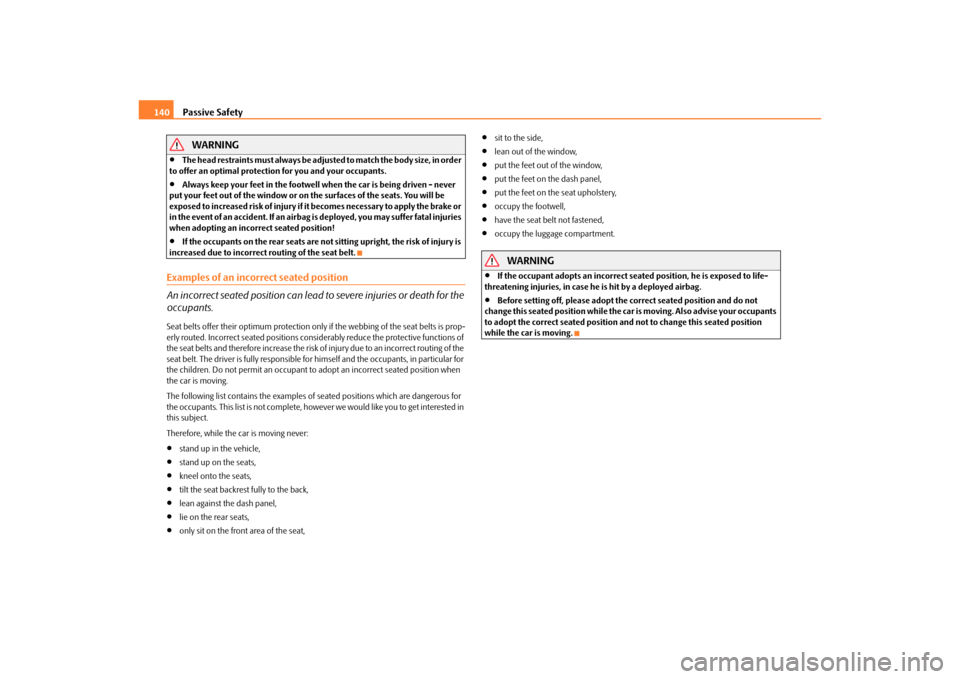
Passive Safety
140WARNING
T h e h e a d re s t ra i n t s m u s t a l w a y s b e a d j u s t e d t o m a t c h t h e b o d y s i z e , i n o rd e r
to offer an optimal protection for you and your occupants.
Always keep your feet in the footwell when the car is being driven - never
put your feet out of the window or on the surfaces of the seats. You will be
exposed to increased risk of injury if it becomes necessary to apply the brake or
in the event of an accident. If an airbag is deployed, you may suffer fatal injuries
when adopting an incorrect seated position!
If the occupants on the rear seats are not sitting upright, the risk of injury is
increased due to incorrect routing of the seat belt.
Examples of an incorrect seated position
An incorrect seated position can lead to severe injuries or death for the
occupants.Seat belts offer their optimum protection only if the webbing of the seat belts is prop-
erly routed. Incorrect seated positions considerably reduce the protective functions of
the seat belts and therefore increase the risk of injury due to an incorrect routing of the
seat belt. The driver is fully responsible for himself and the occupants, in particular for
the children. Do not permit an occupant to adopt an incorrect seated position when
the car is moving.
The following list contains the examples of seated positions which are dangerous for
the occupants. This list is not complete, howe ver we would like you to get interested in
this subject.
Therefore, while the car is moving never:
stand up in the vehicle,
stand up on the seats,
kneel onto the seats,
tilt the seat backrest fully to the back,
lean against the dash panel,
lie on the rear seats,
only sit on the front area of the seat,
sit to the side,
lean out of the window,
put the feet out of the window,
put the feet on the dash panel,
put the feet on the seat upholstery,
occupy the footwell,
have the seat belt not fastened,
occupy the luggage compartment.
WARNING
If the occupant adopts an incorrect seated position, he is exposed to life-
threatening injuries, in case he is hit by a deployed airbag.
Before setting off, please adopt the correct seated position and do not
change this seated position while the car is moving. Also advise your occupants
to adopt the correct seated position and not to change this seated position
while the car is moving.
s2ug.6.book Page 140 Friday, April 9, 2010 2:24 PM
Page 142 of 271
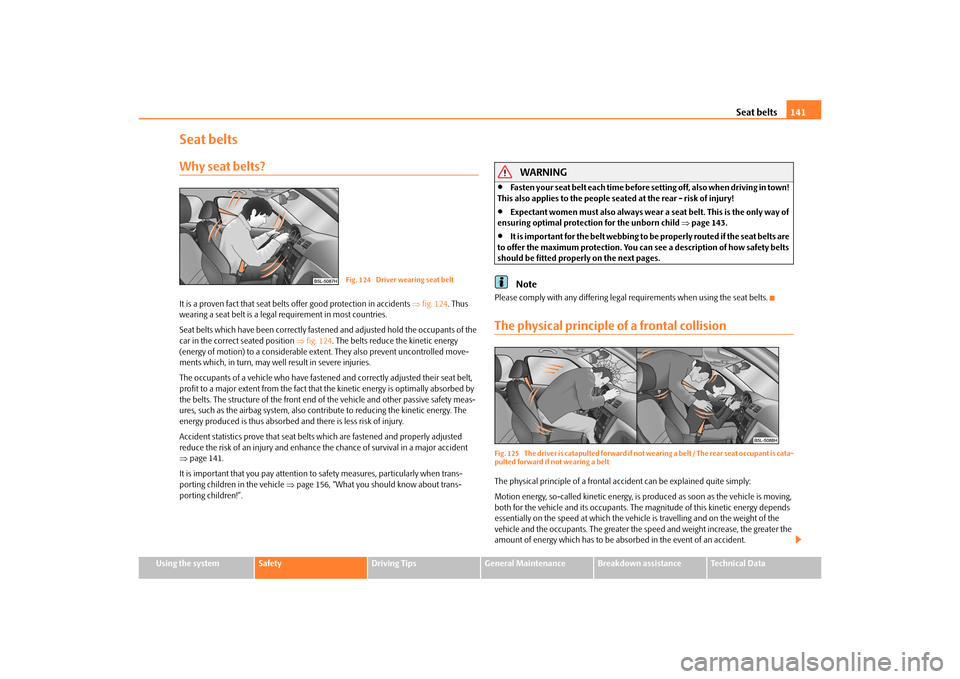
Seat belts141
Using the system
Safety
Driving Tips
General Maintenance
Breakdown assistance
Technical Data
Seat beltsWhy seat belts?It is a proven fact that seat belt s offer good protection in accidents fig. 124 . Thus
wearing a seat belt is a legal requirement in most countries.
Seat belts which have been correctly fasten ed and adjusted hold the occupants of the
car in the correct seated position fig. 124 . The belts reduce the kinetic energy
(energy of motion) to a considerable exte nt. They also prevent uncontrolled move-
ments which, in turn, may well result in severe injuries.
The occupants of a vehicle who have fastened and correctly adjusted their seat belt,
profit to a major extent from the fact that the kinetic energy is optimally absorbed by
the belts. The structure of the front end of the vehicle and other passive safety meas-
ures, such as the airbag system, also cont ribute to reducing the kinetic energy. The
energy produced is thus absorbed and there is less risk of injury.
Accident statistics prove that seat belts which are fastened and properly adjusted
reduce the risk of an injury and enhance the chance of survival in a major accident
page 141.
It is important that you pay attention to safety measures, particularly when trans-
porting children in the vehicle page 156, “What you should know about trans-
porting children!”.
WARNING
Fasten your seat belt each time before setting off, also when driving in town!
This also applies to the people seated at the rear - risk of injury!
Expectant women must also always wear a seat belt. This is the only way of
ensuring optimal protection for the unborn child page 143.
It is important for the belt webbing to be properly routed if the seat belts are
to offer the maximum protection. You can see a description of how safety belts
should be fitted properly on the next pages.Note
Please comply with any differing legal requirements when using the seat belts.The physical principle of a frontal collisionFig. 125 The driver is catapulted forward if not wearing a belt / The rear seat occupant is cata-
pulted forward if not wearing a beltThe physical principle of a frontal a ccident can be explained quite simply:
Motion energy, so-called kinetic energy, is produced as soon as the vehicle is moving,
both for the vehicle and its occupants. The magnitude of this kinetic energy depends
essentially on the speed at which the vehicl e is travelling and on the weight of the
vehicle and the occupants. The greater the speed and weight increase, the greater the
amount of energy which has to be ab sorbed in the event of an accident.
Fig. 124 Driver wearing seat belt
s2ug.6.book Page 141 Friday, April 9, 2010 2:24 PM
Page 143 of 271
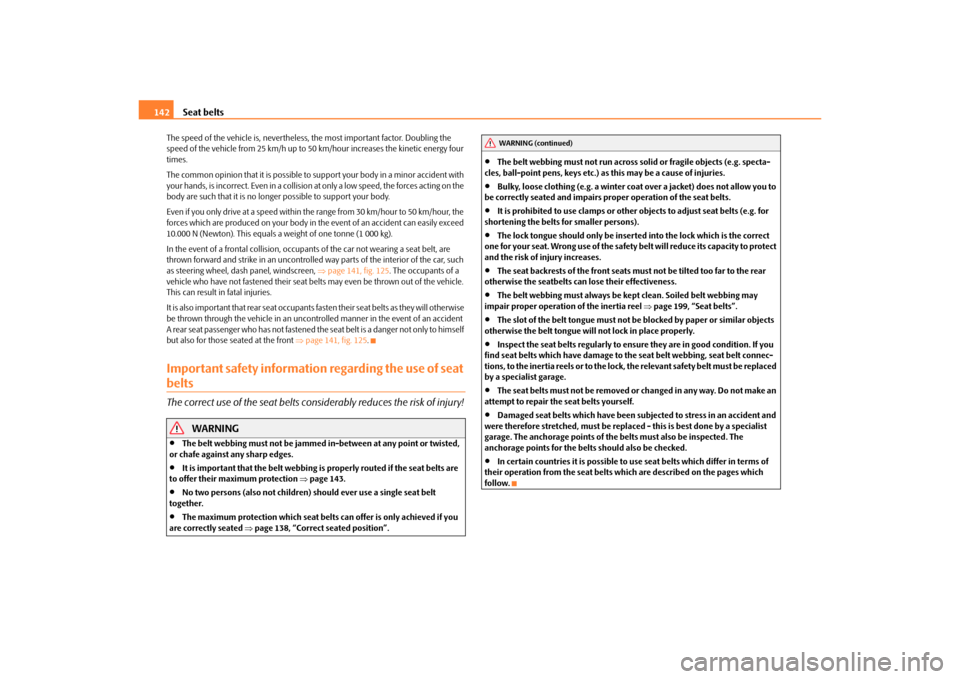
Seat belts
142
The speed of the vehicle is, nevertheless, the most important factor. Doubling the
speed of the vehicle from 25 km/h up to 50 km/hour increases the kinetic energy four
times.
The common opinion that it is possible to su pport your body in a minor accident with
your hands, is incorrect. Even in a collision at only a low speed, the forces acting on the
body are such that it is no longer possible to support your body.
Even if you only drive at a speed within the range from 30 km/hour to 50 km/hour, the
forces which are produced on your body in the event of an accident can easily exceed
10.000 N (Newton). This equals a weight of one tonne (1 000 kg).
In the event of a frontal collision, occupant s of the car not wearing a seat belt, are
thrown forward and strike in an uncontrolled way parts of the interior of the car, such
as steering wheel, da sh panel, windscreen, page 141, fig. 125 . The occupants of a
vehicle who have not fastened their seat belts may even be thrown out of the vehicle.
This can result in fatal injuries.
It is also important that rear seat occupants fasten their seat belts as they will otherwise
be thrown through the vehicle in an uncontr olled manner in the event of an accident
A rear seat passenger who has not fastened the s eat bel t i s a dang er not o nl y to hims elf
but also for those seated at the front page 141, fig. 125 .Important safety information regarding the use of seat beltsThe correct use of the seat belts cons iderably reduces the risk of injury!
WARNING
The belt webbing must not be jammed in-between at any point or twisted,
or chafe against any sharp edges.
It is important that the belt webbing is properly routed if the seat belts are
to offer their maximum protection page 143.
No two persons (also not children) should ever use a single seat belt
together.
The maximum protection which seat belts can offer is only achieved if you
are correctly seated page 138, “Correct seated position”.
The belt webbing must not run across solid or fragile objects (e.g. specta-
cles, ball-point pens, keys etc.) as this may be a cause of injuries.
Bulky, loose clothing (e.g. a winter coat over a jacket) does not allow you to
be correctly seated and impairs proper operation of the seat belts.
It is prohibited to use clamps or other objects to adjust seat belts (e.g. for
shortening the belts for smaller persons).
The lock tongue should only be inserted into the lock which is the correct
one for your seat. Wrong use of the safety belt will reduce its capacity to protect
and the risk of injury increases.
The seat backrests of the front seats must not be tilted too far to the rear
otherwise the seatbelts can lose their effectiveness.
The belt webbing must always be ke pt clean. Soiled belt webbing may
impair proper operation of the inertia reel page 199, “Seat belts”.
The slot of the belt tongue must not be blocked by paper or similar objects
otherwise the belt tongue will not lock in place properly.
Inspect the seat belts regula rly to ensure they are in good condition. If you
find seat belts which have damage to the seat belt webbing, seat belt connec-
tions, to the inertia reels or to the lock, the relevant safety belt must be replaced
by a specialist garage.
The seat belts must not be removed or changed in any way. Do not make an
attempt to repair the seat belts yourself.
Damaged seat belts which have been subjected to stress in an accident and
were therefore stretched, must be replaced - this is best done by a specialist
garage. The anchorage points of the belts must also be inspected. The
anchorage points for the belts should also be checked.
In certain countries it is possible to use seat belts which differ in terms of
their operation from the seat belts which are described on the pages which
follow.WARNING (continued)
s2ug.6.book Page 142 Friday, April 9, 2010 2:24 PM
Page 144 of 271

Seat belts143
Using the system
Safety
Driving Tips
General Maintenance
Breakdown assistance
Technical Data
How are seat belts correctly fastened?Fastening three-point seat belts
Fasten your seat belt before starting!Fig. 126 Routing of belt webbing for an expect ant mother / routing of belt webbing over the
shoulders and the lap belt– Correctly adjust the front seat and the head restraint before fastening your seat belt
page 72.
– Slowly pull the belt webbing at the tongue of the lock over your chest and pelvis
.
– Insert the tongue of the lock into the seat belt buckle belonging to the seat until it is heard to lock in place.
– Pull on the belt to check that it has also reliably engaged in the lock.
Each three-point seat belt is equipped with an inertia reel. This inertia reel offers you
complete freedom of movement if the belt is unreeled slowly. If the brakes are applied
suddenly, the inertia reel will block. It also blocks the belts when the car accelerates,
when driving uphill and when cornering.
Expectant mothers must also wear the seat belt .
WARNING
The shoulder part of the seat belt must never run across your neck but must
run approximately over the middle of the shoulder and fit snugly against the chest. The lap part of the belt must r
un across the hip and must never be routed
across the stomach. It must always fit snugly fig. 126 on the right. Adjust the
belt webbing as required.
The lap part of the belt should be posi tioned as low as possible at the pelvis
of an expectant mother in order to avoid exerting any pressure on the lower
abdomen fig. 126 - left.
Always ensure that the webbing of the seat belts is properly routed. Seat
belts which are not correctl y adjusted can themselves cause injuries even in
minor accidents.
A seat belt which is hanging too loose can result in injuries as your body is
moved forward by the kinetic energy pr oduced in an accident and is then
suddenly held firm by the belt.
Only insert the lock tongue into the lock which is the correct one for your
seat. This will affect the protection which the belt offers and increase the risk of
an injury.
Seat belt height adjusterThe seat belt height adjuster makes it possible for you to adapt the routing of the three-
point seat belt in the area of the shoulder to match your body size.
– Move the height adjuster in the desired direction up or down fig. 127 .
– Then pull firmly on the belt to ensure that the seat belt height adjuster has correctly locked in place.
WARNING (continued)
Fig. 127 Front seat: Seat belt height
adjuster
s2ug.6.book Page 143 Friday, April 9, 2010 2:24 PM
Page 145 of 271
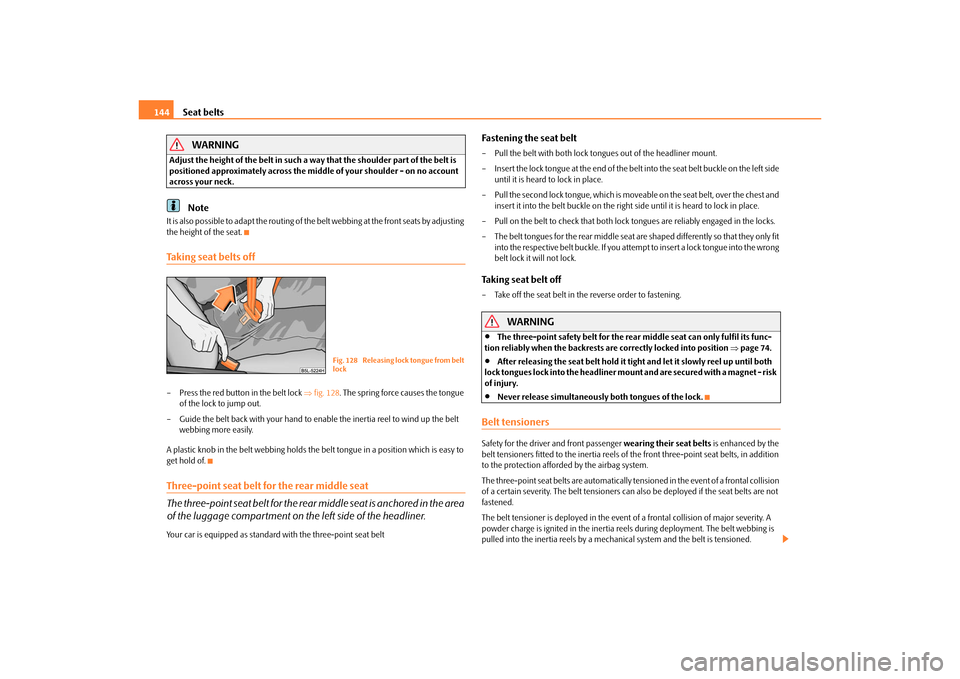
Seat belts
144WARNING
Adjust the height of the belt in such a way that the shoulder part of the belt is
positioned approximately across the middle of your shoulder - on no account
across your neck.
Note
It is also possible to adapt the routing of the belt webbing at the front seats by adjusting
the height of the seat.Taking seat belts off– Press the red button in the belt lock fig. 128 . The spring force causes the tongue
of the lock to jump out.
– Guide the belt back with your hand to en able the inertia reel to wind up the belt
webbing more easily.
A plastic knob in the belt webbing holds the be lt tongue in a position which is easy to
get hold of.Three-point seat belt for the rear middle seat
The three-point seat belt for the rear middle seat is anchored in the area
of the luggage compartment on the left side of the headliner.Your car is equipped as standard with the three-point seat belt
Fastening the seat belt– Pull the belt with both lock to ngues out of the headliner mount.
– Insert the lock tongue at the end of the belt into the seat belt buckle on the left side
until it is heard to lock in place.
– Pull the second lock tongue, which is move able on the seat belt, over the chest and
insert it into the belt buckle on the right side until it is heard to lock in place.
– Pull on the belt to check that both lock tongues are reliably engaged in the locks.
– The belt tongues for the rear middle seat are shaped differently so that they only fit into the respective belt buckle. If you attempt to insert a lock tongue into the wrong
belt lock it will not lock.Taking seat belt off– Take off the seat belt in the reverse order to fastening.
WARNING
The three-point safety belt for the rear middle seat can only fulfil its func-
tion reliably when the backrests are correctly locked into position page 74.
After releasing the seat belt hold it tight and let it slowly reel up until both
lock tongues lock into the headliner mount and are secured with a magnet - risk
of injury.
Never release simultaneously both tongues of the lock.
Belt tensionersSafety for the driver and front passenger wearing their seat belts is enhanced by the
belt tensioners fitted to the inertia reels of the front three-point seat belts, in addition
to the protection afforded by the airbag system.
The three-point seat belts are automatically te nsioned in the event of a frontal collision
of a certain severity. The belt tensioners can also be deployed if the seat belts are not
fastened.
The belt tensioner is deployed in the event of a frontal collision of major severity. A
powder charge is ignited in the inertia re els during deployment. The belt webbing is
pulled into the inertia reels by a mechanical system and the belt is tensioned.
Fig. 128 Releasing lock tongue from belt
lock
s2ug.6.book Page 144 Friday, April 9, 2010 2:24 PM
Page 146 of 271
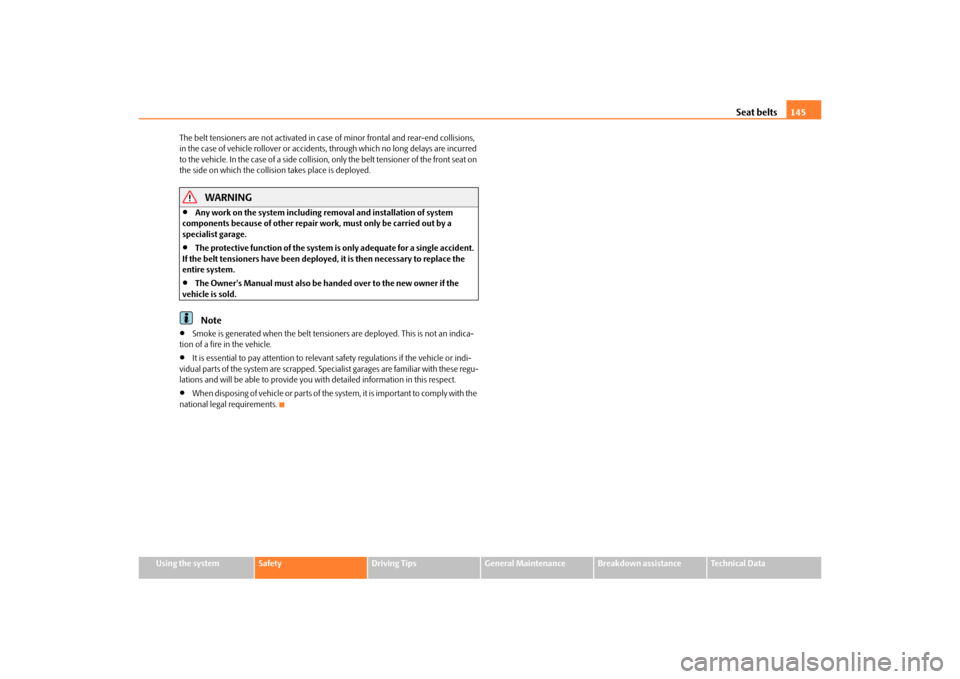
Seat belts145
Using the system
Safety
Driving Tips
General Maintenance
Breakdown assistance
Technical Data
The belt tensioners are not activated in case
of minor frontal and rear-end collisions,
in the case of vehicle rollover or accidents, through which no long delays are incurred
to the vehicle. In the case of a side collision, only the belt tensioner of the front seat on
the side on which the collision takes place is deployed.
WARNING
Any work on the system including removal and installation of system
components because of other repair work, must only be carried out by a
specialist garage.
The protective function of the system is only adequate for a single accident.
If the belt tensioners have been deployed, it is then necessary to replace the
entire system.
The Owner's Manual must also be handed over to the new owner if the
vehicle is sold.Note
Smoke is generated when the belt tensioners are deployed. This is not an indica-
tion of a fire in the vehicle.
It is essential to pay attent ion to relevant safety regulations if the vehicle or indi-
vidual parts of the system are scrapped. Specialist garages are familiar with these regu-
lations and will be able to provide you with detailed information in this respect.
When disposing of vehicle or parts of the system, it is important to comply with the
national legal requirements.
s2ug.6.book Page 145 Friday, April 9, 2010 2:24 PM
Page 147 of 271
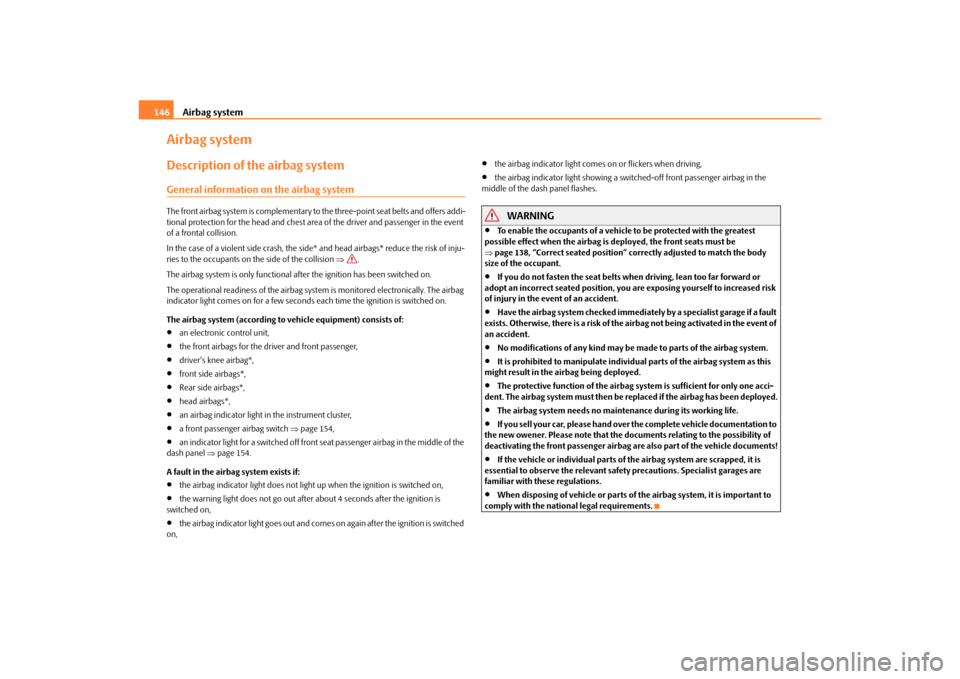
Airbag system
146
Airbag systemDescription of the airbag systemGeneral information on the airbag systemThe front airbag system is complementary to the three-point seat belts and offers addi-
tional protection for the head and chest area of the driver and passenger in the event
of a frontal collision.
In the case of a violent side cr ash, the side* and head airbags* reduce the risk of inju-
ries to the occupants on the side of the collision .
The airbag system is only functional af ter the ignition has been switched on.
The operational readiness of the airbag syst em is monitored electronically. The airbag
indicator light comes on for a few seconds each time the ignition is switched on.
The airbag system (according to vehicle equipment) consists of:
an electronic control unit,
the front airbags for the driver and front passenger,
driver's knee airbag*,
front side airbags*,
Rear side airbags*,
head airbags*,
an airbag indicator light in the instrument cluster,
a front passenger airbag switch page 154,
an indicator light for a switched off front seat passenger airbag in the middle of the
dash panel page 154.
A fault in the airbag system exists if:
the airbag indicator light does not light up when the ignition is switched on,
the warning light does not go out after about 4 seconds after the ignition is
switched on,
the airbag indicator light goes out and come s on again after the ignition is switched
on,
the airbag indicator light comes on or flickers when driving,
the airbag indicator light showing a swit ched-off front passenger airbag in the
middle of the dash panel flashes.
WARNING
To enable the occupants of a vehicle to be protected with the greatest
possible effect when the airbag is deployed, the front seats must be
page 138, “Correct seated position” co rrectly adjusted to match the body
size of the occupant.
If you do not fasten the seat belts when driving, lean too far forward or
adopt an incorrect seated position, you are exposing yourself to increased risk
of injury in the event of an accident.
Have the airbag system checked immediat ely by a specialist garage if a fault
exists. Otherwise, there is a risk of the airbag not being activated in the event of
an accident.
No modifications of any kind may be made to parts of the airbag system.
It is prohibited to manipulate individual parts of the airbag system as this
might result in the airbag being deployed.
The protective function of the airbag system is sufficient for only one acci-
dent. The airbag system must then be re placed if the airbag has been deployed.
The airbag system needs no maintenance during its working life.
If you sell your car, please hand over the complete vehicle documentation to
the new owener. Please note that the documents relating to the possibility of
deactivating the front passenger airbag are also part of the vehicle documents!
If the vehicle or individual parts of the airbag system are scrapped, it is
essential to observe the relevant safety precautions. Specialist garages are
familiar with these regulations.
When disposing of vehicle or parts of the airbag system, it is important to
comply with the national legal requirements.
s2ug.6.book Page 146 Friday, April 9, 2010 2:24 PM
Page 148 of 271
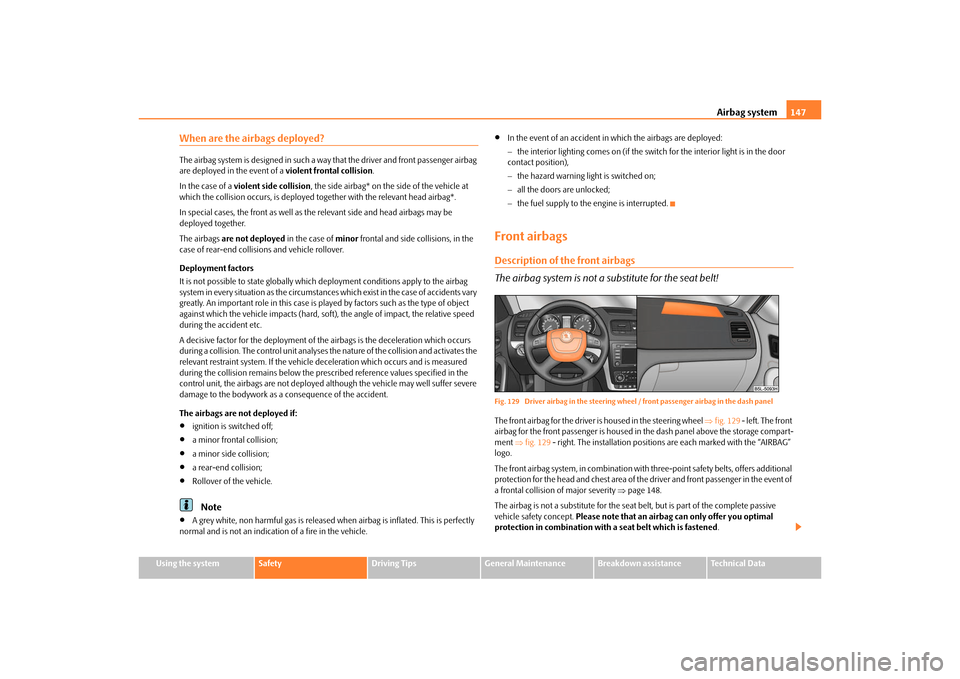
Airbag system147
Using the system
Safety
Driving Tips
General Maintenance
Breakdown assistance
Technical Data
When are the airbags deployed?The airbag system is designed in such a wa y that the driver and front passenger airbag
are deployed in the event of a violent frontal collision.
In the case of a violent side collision , the side airbag* on the side of the vehicle at
which the collision occurs, is deployed to gether with the relevant head airbag*.
In special cases, the front as well as th e relevant side and head airbags may be
deployed together.
The airbags are not deployed in the case of minor frontal and side collisions, in the
case of rear-end collisi ons and vehicle rollover.
Deployment factors
It is not possible to state globally which deployment conditions apply to the airbag
system in every situation as the circumstances which exist in the case of accidents vary
greatly. An important role in this case is played by factors such as the type of object
against which the vehicle impacts (hard, soft ), the angle of impact, the relative speed
during the accident etc.
A decisive factor for the deployment of the airbags is the deceleration which occurs
during a collision. The control unit analyses the nature of the collision and activates the
relevant restraint system. If the vehicle deceleration which occurs and is measured
during the collision remains below the prescribed reference values specified in the
control unit, the airbags are no t deployed although the vehicle may well suffer severe
damage to the bodywork as a consequence of the accident.
The airbags are not deployed if:
ignition is switched off;
a minor frontal collision;
a minor side collision;
a rear-end collision;
Rollover of the vehicle.Note
A grey white, non harmful gas is released when airbag is inflated. This is perfectly
normal and is not an indicati on of a fire in the vehicle.
In the event of an accident in which the airbags are deployed:
the interior lighting comes on (if the swit ch for the interior light is in the door
contact position),
the hazard warning li ght is switched on;
all the doors are unlocked;
the fuel supply to the engine is interrupted.
Front airbagsDescription of the front airbags
The airbag system is not a su bstitute for the seat belt!Fig. 129 Driver airbag in the steering wheel / front passenger airbag in the dash panelThe front airbag for the driver is housed in the steering wheel fig. 129 - left. The front
airbag for the front passenger is housed in the dash panel above the storage compart-
ment fig. 129 - right. The installation positions are each marked with the “AIRBAG”
logo.
The front airbag system, in combination with three-point safety belts, offers additional
protection for the head and chest area of the driver and front passenger in the event of
a frontal collision of major severity page 148.
The airbag is not a substitute for the seat belt, but is part of the complete passive
vehicle safety concept. Please note that an airbag can only offer you optimal
protection in combination with a seat belt which is fastened .
s2ug.6.book Page 147 Friday, April 9, 2010 2:24 PM
Page 149 of 271
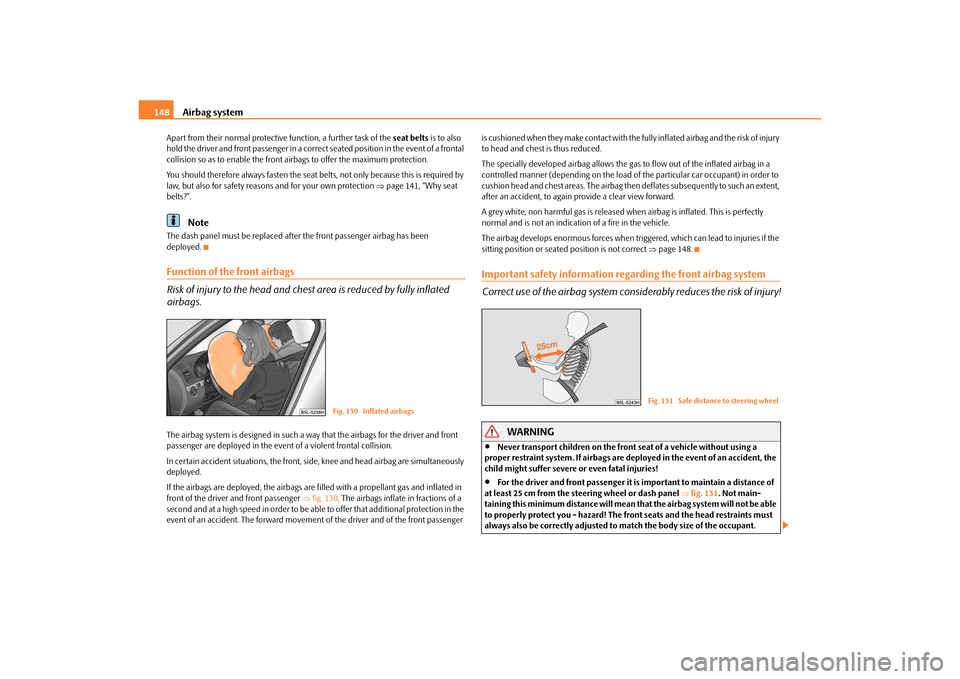
Airbag system
148
Apart from their normal protective function, a further task of the seat belts is to also
hold the driver and front passenger in a correct seated position in the event of a frontal
collision so as to enable the front ai rbags to offer the maximum protection.
You should therefore always fasten the seat be lts, not only because this is required by
law, but also for safety reasons and for your own protection page 141, “Why seat
belts?”.
Note
The dash panel must be replaced after the front passenger airbag has been
deployed.Function of the front airbags
Risk of injury to the head and ches t area is reduced by fully inflated
airbags.The airbag system is designed in such a wa y that the airbags for the driver and front
passenger are deployed in the event of a violent frontal collision.
In certain accident situations, the front, side , knee and head airbag are simultaneously
deployed.
If the airbags are deployed, the airbags are filled with a propellant gas and inflated in
front of the driver and front passenger fig. 130 . The airbags inflate in fractions of a
second and at a high speed in order to be able to offer that additional protection in the
event of an accident. The forward movement of the driver and of the front passenger i s c us h i o n e d w h e n th e y m a ke co n t a c t w i t h t h e f u l l y i n f l a t e d a i r ba g a n d th e r i s k o f i n j u r y
to head and chest is thus reduced.
The specially developed airbag allows the gas
to flow out of the inflated airbag in a
controlled manner (depending on the load of the particular car occupant) in order to
cushion head and chest areas. The airbag then deflates subsequently to such an extent,
after an accident, to again provide a clear view forward.
A grey white, non harmful gas is released when airbag is inflated. This is perfectly
normal and is not an indicati on of a fire in the vehicle.
The airbag develops enormous forces when triggered, which can lead to injuries if the
sitting position or seated position is not correct page 148.
Important safety information regarding the front airbag system
Correct use of the airbag system cons iderably reduces the risk of injury!
WARNING
Never transport children on the front seat of a vehicle without using a
proper restraint system. If airbags are de ployed in the event of an accident, the
child might suffer severe or even fatal injuries!
For the driver and front passenger it is important to maintain a distance of
at least 25 cm from the steering wheel or dash panel fig. 131 . Not main-
taining this minimum distance will mean that the airbag system will not be able
to properly protect you - hazard! The front seats and the head restraints must
always also be correctly adjusted to match the body size of the occupant.
Fig. 130 Inflated airbags
Fig. 131 Safe distance to steering wheel
s2ug.6.book Page 148 Friday, April 9, 2010 2:24 PM
Page 150 of 271
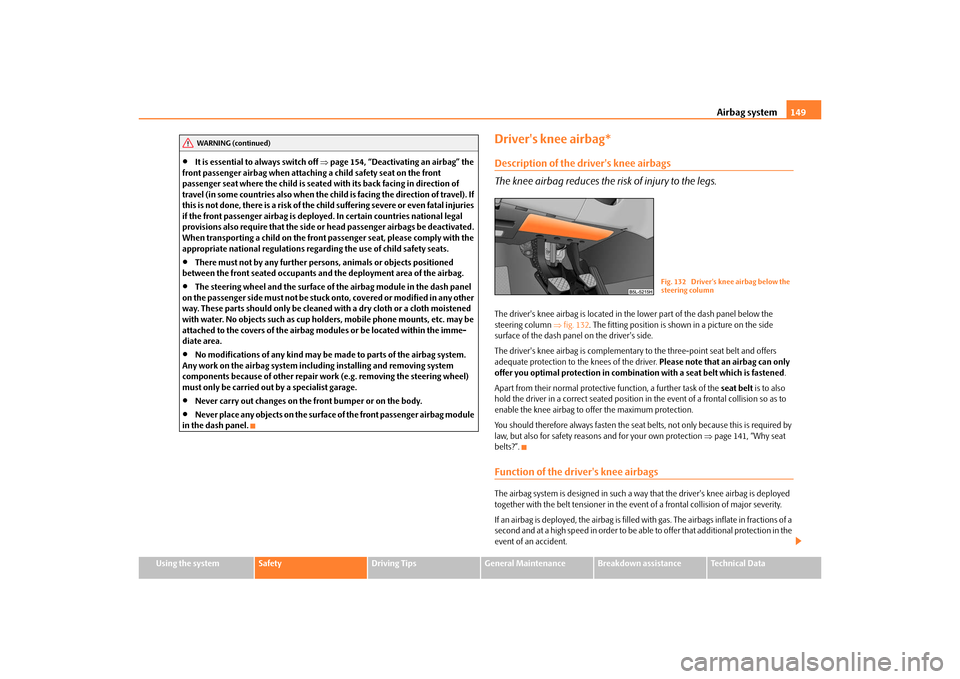
Airbag system149
Using the system
Safety
Driving Tips
General Maintenance
Breakdown assistance
Technical Data
It is essential to always switch off page 154, “Deactivating an airbag” the
front passenger airbag when attaching a child safety seat on the front
passenger seat where the child is seated with its back facing in direction of
travel (in some countries also when the child is facing the direction of travel). If
this is not done, there is a risk of the ch ild suffering severe or even fatal injuries
if the front passenger airbag is deploy ed. In certain countries national legal
provisions also require that the side or head passenger airbags be deactivated.
When transporting a child on the front passenger seat, please comply with the
appropriate national regu lations regarding the use of child safety seats.
There must not by any further persons, animals or objects positioned
between the front seated occupants and the deployment area of the airbag.
The steering wheel and the surface of the airbag module in the dash panel
on the passenger side must not be stuck onto, covered or modified in any other
way. These parts should only be cleaned with a dry cloth or a cloth moistened
with water. No objects such as cup holders, mobile phone mounts, etc. may be
attached to the covers of the airbag modules or be located within the imme-
diate area.
No modifications of any kind may be made to parts of the airbag system.
Any work on the airbag system including installing and removing system
components because of other repair wo rk (e.g. removing the steering wheel)
must only be carried out by a specialist garage.
Never carry out changes on the front bumper or on the body.
Never place any objects on the surface of the front passenger airbag module
in the dash panel.
Driver's knee airbag*Description of the driver's knee airbags
The knee airbag reduces the risk of injury to the legs.The driver's knee airbag is located in th e lower part of the dash panel below the
steering column fig. 132 . The fitting position is show n in a picture on the side
surface of the dash panel on the driver's side.
The driver's knee airbag is complementary to the three-point seat belt and offers
adequate protection to the knees of the driver. Please note that an airbag can only
offer you optimal protection in combination with a seat belt which is fastened .
Apart from their normal protective function, a further task of the seat belt is to also
hold the driver in a correct seated position in the event of a frontal collision so as to
enable the knee airbag to offer the maximum protection.
You should therefore always fasten the seat belts, not only because this is required by
law, but also for safety reasons and for your own protection page 141, “Why seat
belts?”.Function of the driver's knee airbagsThe airbag system is designed in such a way that the driver's knee airbag is deployed
together with the belt tensioner in the even t of a frontal collision of major severity.
If an airbag is deployed, the airbag is filled with gas. The airbags inflate in fractions of a
second and at a high speed in order to be able to offer that additional protection in the
event of an accident.
WARNING (continued)
Fig. 132 Driver's knee airbag below the
steering column
s2ug.6.book Page 149 Friday, April 9, 2010 2:24 PM